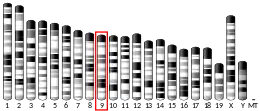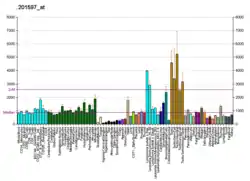| COX7A2 | |||||||||||||||||||||||||||||||||||||||||||||||||||
|---|---|---|---|---|---|---|---|---|---|---|---|---|---|---|---|---|---|---|---|---|---|---|---|---|---|---|---|---|---|---|---|---|---|---|---|---|---|---|---|---|---|---|---|---|---|---|---|---|---|---|---|
| Identifiers | |||||||||||||||||||||||||||||||||||||||||||||||||||
| Aliases | COX7A2, COX7AL, COX7AL1, COXVIIAL, COXVIIa-L, VIIAL, cytochrome c oxidase subunit 7A2 | ||||||||||||||||||||||||||||||||||||||||||||||||||
| External IDs | OMIM: 123996 MGI: 1316715 HomoloGene: 36082 GeneCards: COX7A2 | ||||||||||||||||||||||||||||||||||||||||||||||||||
| |||||||||||||||||||||||||||||||||||||||||||||||||||
| |||||||||||||||||||||||||||||||||||||||||||||||||||
| |||||||||||||||||||||||||||||||||||||||||||||||||||
| |||||||||||||||||||||||||||||||||||||||||||||||||||
| |||||||||||||||||||||||||||||||||||||||||||||||||||
| Wikidata | |||||||||||||||||||||||||||||||||||||||||||||||||||
| |||||||||||||||||||||||||||||||||||||||||||||||||||
Cytochrome c oxidase polypeptide 7A2, mitochondrial is an enzyme that in humans is encoded by the COX7A2 gene.[5][6][7]
Cytochrome c oxidase (COX), the terminal component of the mitochondrial respiratory chain, catalyzes the electron transfer from reduced cytochrome c to oxygen.
This component is a heteromeric complex consisting of 3 catalytic subunits encoded by mitochondrial genes and multiple structural subunits encoded by nuclear genes. The mitochondrially encoded subunits function in electron transfer, and the nuclear-encoded subunits may function in the regulation and assembly of the complex. This nuclear gene encodes polypeptide 2 (liver isoform) of subunit VIIa and the polypeptide 2 is present in both muscle and nonmuscle tissues.
In addition to polypeptide 2, subunit VIIa includes polypeptide 1 (muscle isoform), which is present only in muscle tissues, and a related protein, present in all tissues. This gene may have several pseudogenes.[7]
References
- 1 2 3 GRCh38: Ensembl release 89: ENSG00000112695 - Ensembl, May 2017
- 1 2 3 GRCm38: Ensembl release 89: ENSMUSG00000032330 - Ensembl, May 2017
- ↑ "Human PubMed Reference:". National Center for Biotechnology Information, U.S. National Library of Medicine.
- ↑ "Mouse PubMed Reference:". National Center for Biotechnology Information, U.S. National Library of Medicine.
- ↑ Arnaudo E, Hirano M, Seelan RS, Milatovich A, Hsieh CL, Fabrizi GM, Grossman LI, Francke U, Schon EA (Nov 1992). "Tissue-specific expression and chromosome assignment of genes specifying two isoforms of subunit VIIa of human cytochrome c oxidase". Gene. 119 (2): 299–305. doi:10.1016/0378-1119(92)90287-Y. PMID 1327965.
- ↑ Merante F, Duncan AM, Mitchell G, Duff C, Rommens J, Robinson BH (Aug 1997). "Chromosomal localization of the human liver form cytochrome c oxidase subunit VIIa gene". Genome. 40 (3): 318–24. doi:10.1139/g97-044. PMID 9202412.
- 1 2 "Entrez Gene: COX7A2 cytochrome c oxidase subunit VIIa polypeptide 2 (liver)".
External links
- Human COX7A2 genome location and COX7A2 gene details page in the UCSC Genome Browser.
Further reading
- Lenka N, Vijayasarathy C, Mullick J, Avadhani NG (1998). "Structural Organization and Transcription Regulation of Nuclear Genes Encoding the Mammalian Cytochrome c Oxidase Complex". Prog. Nucleic Acid Res. Mol. Biol. Progress in Nucleic Acid Research and Molecular Biology. 61: 309–44. doi:10.1016/S0079-6603(08)60830-2. ISBN 978-0-12-540061-9. PMID 9752724.
- Van Kuilenburg AB, Van Beeumen JJ, Van der Meer NM, Muijsers AO (1992). "Subunits VIIa,b,c of human cytochrome c oxidase. Identification of both 'heart-type' and 'liver-type' isoforms of subunit VIIa in human heart". Eur. J. Biochem. 203 (1–2): 193–9. doi:10.1111/j.1432-1033.1992.tb19847.x. PMID 1309697.
- Fabrizi GM, Rizzuto R, Nakase H, et al. (1989). "Sequence of a cDNA specifying subunit VIIa of human cytochrome c oxidase". Nucleic Acids Res. 17 (17): 7107. doi:10.1093/nar/17.17.7107. PMC 318441. PMID 2550906.
- Taanman JW, Hall RE, Tang C, et al. (1993). "Tissue distribution of cytochrome c oxidase isoforms in mammals. Characterization with monoclonal and polyclonal antibodies". Biochim. Biophys. Acta. 1225 (1): 95–100. doi:10.1016/0925-4439(93)90128-n. PMID 8241294.
- Merante F, Ling M, Duncan AM, et al. (1997). "Cloning, characterization, and chromosomal localization of human liver form cytochrome c oxidase subunit VIa related genes". Genome. 40 (3): 325–31. doi:10.1139/g97-045. PMID 9202413.
- Hüttemann M, Mühlenbein N, Schmidt TR, et al. (2000). "Isolation and sequence of the human cytochrome c oxidase subunit VIIaL gene". Biochim. Biophys. Acta. 1492 (1): 252–8. doi:10.1016/s0167-4781(00)00087-7. PMID 11004498.
- Strausberg RL, Feingold EA, Grouse LH, et al. (2003). "Generation and initial analysis of more than 15,000 full-length human and mouse cDNA sequences". Proc. Natl. Acad. Sci. U.S.A. 99 (26): 16899–903. Bibcode:2002PNAS...9916899M. doi:10.1073/pnas.242603899. PMC 139241. PMID 12477932.
- Mungall AJ, Palmer SA, Sims SK, et al. (2003). "The DNA sequence and analysis of human chromosome 6". Nature. 425 (6960): 805–11. Bibcode:2003Natur.425..805M. doi:10.1038/nature02055. PMID 14574404.
- Gerhard DS, Wagner L, Feingold EA, et al. (2004). "The status, quality, and expansion of the NIH full-length cDNA project: the Mammalian Gene Collection (MGC)". Genome Res. 14 (10B): 2121–7. doi:10.1101/gr.2596504. PMC 528928. PMID 15489334.




